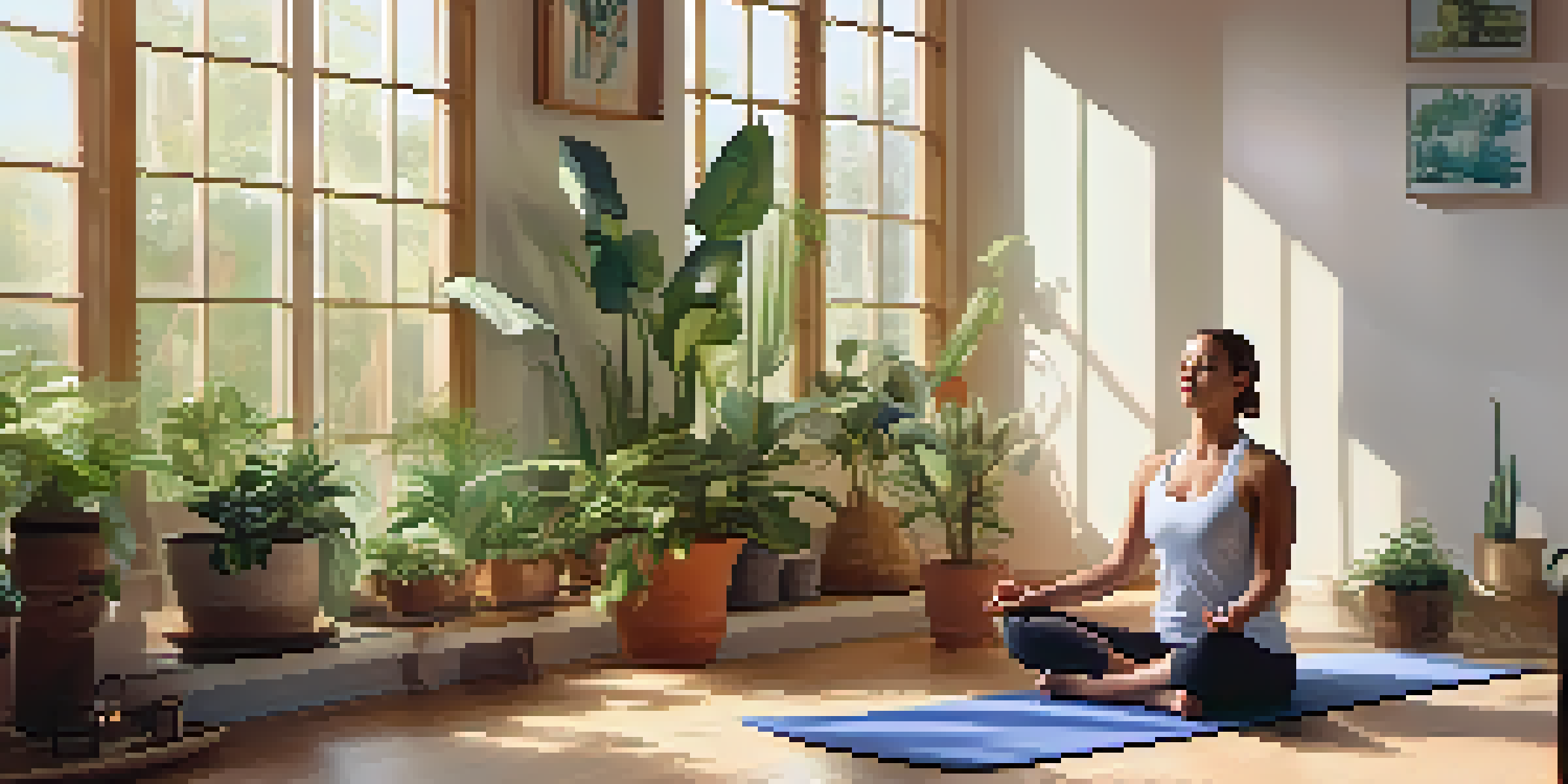Yoga Poses That Prepare You for a Deeper Meditation Session

The Importance of Preparing for Meditation
Meditation is a powerful tool for achieving mental clarity and emotional balance, but diving in without preparation can be challenging. Just like warming up before a workout helps prevent injury, preparing your body for meditation can enhance your experience. The right yoga poses can help you release tension, improve your focus, and create a more conducive environment for meditation.
Meditation is the soul's perspective glass.
By incorporating specific yoga poses into your routine, you can create a seamless transition from physical activity to stillness. This preparation allows your mind to settle and your body to relax, making it easier to slip into a meditative state. Ultimately, these poses can help you cultivate a deeper connection with yourself and your practice.
So, let's explore several effective yoga poses that can get you ready to dive deep into meditation. Each pose offers unique benefits, helping you align your body, mind, and spirit for an enriching experience.
Child's Pose: Finding Inner Calm
Child's Pose, or Balasana, is a gentle resting position that encourages relaxation and introspection. By kneeling and folding forward, you create a safe space to let go of stress and tension. This pose stretches the back, hips, and thighs, promoting a sense of release that is essential for meditation.

As you settle into Child's Pose, focus on your breath, feeling it rise and fall with each inhalation and exhalation. This mindfulness practice can help quiet your mind, making it easier to transition into meditation. Remember, the goal is to cultivate a sense of peace and calm, allowing you to let go of distractions.
Prepare Your Body for Meditation
Incorporating specific yoga poses can enhance your meditation experience by releasing tension and promoting relaxation.
Incorporating Child's Pose into your routine before meditation can help ground you, providing a moment of stillness to prepare for deeper reflection.
Seated Forward Bend: Stretching for Stillness
The Seated Forward Bend, or Paschimottanasana, is another excellent pose for preparing your mind and body for meditation. This pose stretches the spine and hamstrings while promoting relaxation and introspection. By bending forward, you're encouraged to turn your focus inward, setting the stage for a deeper meditative experience.
The mind is everything. What you think you become.
As you fold forward, aim to keep your spine long rather than rounding your back. This alignment allows for a more profound connection with your breath and body. The gentle stretch can help release physical tension, making it easier to find stillness in your mind.
By practicing Seated Forward Bend regularly, you train your body to embrace the calm necessary for effective meditation. This pose acts as a bridge, guiding you from physical exertion to mental clarity.
Cat-Cow Pose: Moving with Breath
Cat-Cow Pose, or Marjaryasana-Bitilasana, is a dynamic duo that warms up the spine and encourages breath awareness. This gentle flow between arching and rounding the back helps release tension and increases flexibility. Engaging in this movement prepares your body for the stillness of meditation by promoting relaxation.
As you transition between these two poses, focus on synchronizing your breath with your movements. Inhale deeply as you arch your back, and exhale fully as you round it. This rhythmic pattern not only calms the nervous system but also clears mental clutter, making it easier to settle into a meditative state.
Yoga Poses for Mindfulness
Practicing poses like Child's Pose and Seated Forward Bend helps cultivate a deeper connection with yourself, paving the way for effective meditation.
Incorporating Cat-Cow into your pre-meditation routine can help you become more attuned to your body and breath, fostering a deeper sense of connection as you transition into meditation.
Legs-Up-the-Wall Pose: Rest and Restore
Legs-Up-the-Wall Pose, or Viparita Karani, is a restorative pose that encourages relaxation and rejuvenation. By lying on your back with your legs extended up a wall, you're able to relieve tension in the lower body and promote blood circulation. This gentle inversion can help calm the mind, setting the stage for a deeper meditation practice.
As you hold this pose, take time to focus on your breath. Feel the gentle rise and fall of your abdomen, allowing any lingering stress to melt away. This practice of mindful breathing helps prepare your mind for the stillness that meditation requires.
Including Legs-Up-the-Wall Pose in your routine can create a profound sense of peace, making it an ideal choice for those moments when you seek a deeper connection with your inner self.
Reclining Bound Angle Pose: Opening the Heart
Reclining Bound Angle Pose, or Supta Baddha Konasana, is a heart-opening pose that encourages deep relaxation. By lying back with your feet together and knees splayed out to the sides, you create space in the chest and hips. This openness not only relaxes the body but also invites emotional release, essential for deep meditation.
As you settle into this pose, focus on your breath, allowing your body to sink into the ground beneath you. This grounding sensation can help you feel more connected and centered, making it easier to transition into meditation. Embrace the stillness and let any distractions drift away.
Establish a Consistent Routine
Creating a regular practice that includes yoga can significantly improve your ability to slip into a meditative state and foster self-discovery.
Practicing Reclining Bound Angle Pose before meditation can help cultivate an open heart and a peaceful mind, enhancing your overall experience.
Corpse Pose: Embracing Stillness
Corpse Pose, or Savasana, is often considered the ultimate relaxation pose. By lying flat on your back with your arms at your sides, you allow your body to fully surrender and relax. This pose is essential for preparing both body and mind for meditation, as it encourages complete stillness and awareness.
As you practice Savasana, focus on releasing any tension and allowing your breath to flow naturally. This state of deep relaxation is crucial for transitioning into meditation, as it creates a blank canvas for your thoughts to settle. Embrace the moment, and let go of any expectations.

Incorporating Corpse Pose into your routine can help you cultivate a sense of peace and presence, paving the way for a transformative meditation practice.
Creating a Consistent Routine for Meditation
Establishing a consistent routine that includes these yoga poses can significantly enhance your meditation practice. Just as athletes train regularly to improve their performance, incorporating yoga into your daily life can prepare your body and mind for deeper meditation. Over time, you'll notice how these poses help you connect more profoundly with your inner self.
Aim to dedicate a few minutes each day to practice these poses before your meditation sessions. This commitment not only fosters discipline but also creates a sense of ritual around your practice. As you become more familiar with the poses, you may find it easier to slip into a meditative state.
Prepare for Meditation
Incorporating yoga poses into your routine can enhance your meditation experience by promoting relaxation and focus.
Ultimately, the key to a fulfilling meditation experience lies in preparation. By making these yoga poses a regular part of your routine, you’ll create an environment that nurtures mindfulness and self-discovery.